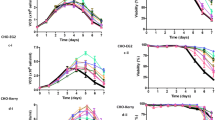Summary
We have tried to pinpoint some of the factors in SCP production which we believe are of significance if SCP is to become a useful protein source. While much remains to be learned about SCP, many groups in this country and abroad are working actively on various aspects of the problem, and it is likely that within five years, SCP production will have a significant impact on the nutrition of many people.
Similar content being viewed by others
Literature Cited
Anonymous. 1965. Japan to use more algae as animal feed. Chem. Eng. News1965 (Aug. 16): 54–56.
Anonymous. 1966. New push in proteiufrom-hydrocarbon projects. Chem. Eng. News1966 (Sept. 12): 110–111.
Brinbaum, S. M., M. Winitz, & J. P. Greenstein. 1957. Quantitative nutritional studies with water-soluble chemically defined diets. III. Individual amino acids as sources of non-essential nitrogen. Arch. Biochem. Biophys.72: 428–436.
Bunker, H. J. 1963. Microbial food, p. 34 to 67.In C. Rainbow and A. H. Rose [ed.] Biochemistry of industrial microorganisms. Academic Press, New York.
Champagnat, A., C. Vernet, B. Lainé, & J. Filosa. 1963. Biosynthesis of proteinvitamin concentrates from petroleum. Nature197: 13–14.
Darlington, W. A. 1964. Aerobic hydrocarbon fermentation—a practical evaluation. Biotech. Bioeng.6: 241–242.
Guenther, K. R. 1965. Aerobic hydrocarbon fermentation⊕ thermodynamic evaluation. Biotech. Bioeng.7: 445–446.
Institut Français du Pétrole. 1967. A new type of food algae. Publication 14–237A. March.
Johnson, M. J. 1967. Growth of microbial cells on hydrocarbons. Science155: 1515–1519.
Mateles, R. I., J. N. Baruah, & S. E. Tannenbaum. 1967. Growth of a thermophilic bacterium on hydrocarbon: a new source of SCP. Science157: 1322–1323.
McNab, J. G., & L. R. Rey. 1966. Potential for single-cell protein. Paper presented at the meeting of the American Association for the Advancement of Science, Washington, D. C. December 27, 1966.
Oswald, W. J. 1963. The high rate pond in waste disposal. Develop. Ind. Microbiol.4: 112–119.
Otsuka, S. I., R. Ishii, & N. Katsuya. 1966. Utilization of hydrocarbons as carbon sources in production of yeast cells. J. Gen. Appl. Microbiol. (Tokyo)12: 1–11.
Purser, D. B., & S. M. Buechler. 1966. Amino acid composition of rumen organisms. J. Dairy Sci.49: 81–84.
Scrimshaw, N. S., R. Bressani, D. Wilson, & M. Béhar. 1962. All vegetable protein mixtures for human feeding. X. Effect of torula yeast on protein quality in INCAP mixture 9. Amer. J. Clin. Nutr.11: 537–542.
Stokes, J. L. 1958. Microbial proteins, p. 789 to 804.In A. Altschul [ed.] Processed plant protein foodstuffs. Academic Press, New York.
Stokes, J. L., & M. Gunness. 1946. The amino acid composition of microorganisms. J. Baeteriol.52: 195–207.
Sugahara, M., T. Morimoto, T. Kobayashi, & S. Ariyoshi. 1967. The nutritional value of D-amino acid in the chick nutrition. Agr. Biol. Chem. (Tokyo)31: 77–84.
Tannenbaum, S. R., & S. A. Miller. 1967. Effect of cell fragmentation on nutritive value ofBacillus megaterium protein. Nature214: 1261–1262.
Tannenbaum, S. E., R. I. Mateles, & G. E. Capco. 1966. Processing of bacteria for production of protein concentrates, p. 254 to 260.In World protein resources, Advances in Chemistry Series No. 57, American Chemical Society, Washington, D. C.
Author information
Authors and Affiliations
Additional information
Delivered at the 8th Annual Meeting of The Society for Economic Botany as part of a symposium “Integrated Eesearch in Economic Botany VII. Protein for Food,” University of Miami, Coral Gables, Florida, June 5–8, 1967. Received for publication June 26, 1967.
Rights and permissions
About this article
Cite this article
Matelbs, R.I., Tannenbaum, S.E. Single-Cell protein. Econ Bot 22, 42–50 (1968). https://doi.org/10.1007/BF02897743
Issue Date:
DOI: https://doi.org/10.1007/BF02897743




